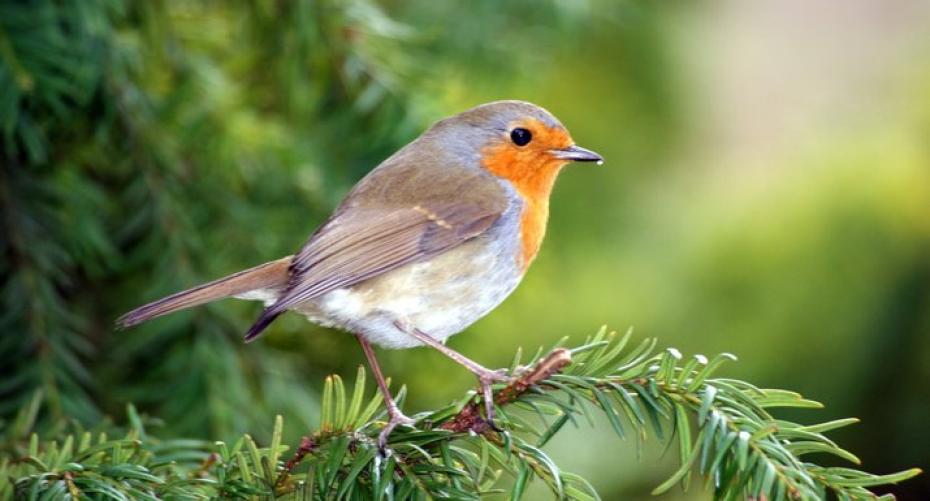By feeding the birds all year round we give them a better chance to survive the periods of natural food shortage, whenever they may occur. Providing birds with supplementary food brings them closer for us to see their exciting behaviour and wonderful colours. Attracting birds to your garden has other benefits too because they will naturally hunt for the insects and pests that are living on your plants. Don't be too tidy, leaving your perennial top growth until spring not only protects the crown but also provides areas that birds can forage for over-wintering insects. Now the weather is deteriorating and food sources are becoming rarer, the birds rely even more on garden feeding stations. Not only does this see them through severe weather and food shortages but it ensures that they will enter next years breeding season in good condition.
Put out food and water on a regular basis and in severe weather check your feeders every day. Birds require high energy (high fat) foods during the cold winter weather as they need to maintain their body reserves to survive the frosty nights. Use only good quality food and scraps. Always adjust the quantity given to the demand, and never allow uneaten food to accumulate around the feeders. Once you establish a feeding routine, try not to change it.
There are different mixes of bird food and the form they come in will determine whether you use a hanging feeder or scatter on bird tables or the ground. The better mixtures contain plenty of flaked maize, sunflower seeds, and peanut granules. Small seeds, such as millet, attract mostly house sparrows, dunnocks, finches, reed buntings and collared doves, while flaked maize is taken readily by blackbirds. Mixes that contain chunks or whole nuts are suitable for winter feeding only as young birds would choke on the larger pieces unless they are in a small mesh feeder.
 High fat or oil content is especially important in winter feeding. Black sunflower seeds have a higher oil content than striped ones, and so they are much better. Peanuts are rich in fat and are popular with tits, greenfinches, house sparrows, nuthatches, great spotted woodpeckers and siskins. Crushed or grated nuts attract robins, dunnocks and even wrens. Peanuts can be high in a natural toxin (aflatoxin) which can kill birds, so ensure you buy peanuts from a reputable source that have been aflatoxin tested. Nyjer seeds also have a high oil content but because they are so small they need a special type of seed feeder. It is worth the effort though because they attract families of goldfinches and siskins.
High fat or oil content is especially important in winter feeding. Black sunflower seeds have a higher oil content than striped ones, and so they are much better. Peanuts are rich in fat and are popular with tits, greenfinches, house sparrows, nuthatches, great spotted woodpeckers and siskins. Crushed or grated nuts attract robins, dunnocks and even wrens. Peanuts can be high in a natural toxin (aflatoxin) which can kill birds, so ensure you buy peanuts from a reputable source that have been aflatoxin tested. Nyjer seeds also have a high oil content but because they are so small they need a special type of seed feeder. It is worth the effort though because they attract families of goldfinches and siskins.
Another good winter food source is bird cake, suet treats and fat balls. Remove the nylon mesh bags before putting the fat ball out because they can trap and injure birds. Polyunsaturated margarines or vegetable oils are unsuitable for birds. Unlike humans, birds need high levels of saturated fat, such as raw suet and lard. They need the high energy content to keep warm in the worst of the winter weather, since their body reserves are quickly used up, particularly on cold winter nights.
Hygiene is as important with birds as it is with humans, so remove any mouldy or stale food from your feeding station. Many moulds are harmless, but some can cause respiratory infections in birds and stale food provides a breeding ground for salmonella bacteria. At least one type of salmonella causes death among such species as greenfinches and house sparrows. If food turns mouldy or stale on your bird table, you are probably placing out too large a quantity for the birds to eat in one day. Also try to avoid large quantities of food scattered on the ground as this may attract mice and rats which carry diseases.
 Take a look at the huge range of bird feeders and bird food we have on the website. The food you put out will determine the birds you attract and also what sort of feeding station you need. Aesthetics and practicalities come into it too as you will be the one maintaining and replenishing the feeder. You can buy a feeder as a treat for yourself or put together a selection of different feeders with the appropriate food as a gift for the ornithologist in the family!
Take a look at the huge range of bird feeders and bird food we have on the website. The food you put out will determine the birds you attract and also what sort of feeding station you need. Aesthetics and practicalities come into it too as you will be the one maintaining and replenishing the feeder. You can buy a feeder as a treat for yourself or put together a selection of different feeders with the appropriate food as a gift for the ornithologist in the family!




![Kingsbury-bench-05[1].jpg](http://www.hayesgardenworld.co.uk/cdn/shop/files/Kingsbury-bench-05_5B1_5D.jpg?v=1712162737&width=1500)
![Kingsbury-bench-01[1].jpg](http://www.hayesgardenworld.co.uk/cdn/shop/files/Kingsbury-bench-01_5B1_5D.jpg?v=1712161065&width=1500)
![tw17a-4947_0[1].jpg](http://www.hayesgardenworld.co.uk/cdn/shop/files/tw17a-4947_0_5B1_5D.jpg?v=1712161495&width=1500)
![tw17a-4947_tenbury_5ft[1].jpg](http://www.hayesgardenworld.co.uk/cdn/shop/files/tw17a-4947_tenbury_5ft_5B1_5D.jpg?v=1712161172&width=1500)
![tw17a-4952_tenbury_4ft[1].jpg](http://www.hayesgardenworld.co.uk/cdn/shop/files/tw17a-4952_tenbury_4ft_5B1_5D.jpg?v=1712161034&width=1500)
![thumbnail_IMG_1565-kik_2[1].jpg](http://www.hayesgardenworld.co.uk/cdn/shop/files/thumbnail_IMG_1565-kik_2_5B1_5D.jpg?v=1712226536&width=1500)
![thumbnail_IMG_1565-kik_1[3].jpg](http://www.hayesgardenworld.co.uk/cdn/shop/files/thumbnail_IMG_1565-kik_1_5B3_5D.jpg?v=1712159637&width=1500)



![WD-XgESA[1].jpeg](http://www.hayesgardenworld.co.uk/cdn/shop/files/WD-XgESA_5B1_5D.jpg?v=1712159609&width=1500)